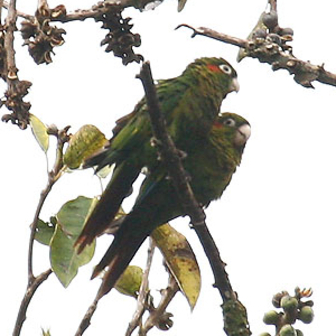Sulphur-winged Parakeet
The Sulphur-winged Parakeet is 23 cm long and weighs 75 g. The adult is mainly green. Scaled with orange-yellow on the head and chest. There is a red spot on the auriculars and the tail is broadly tipped dull red . The outer primaries are blue, but the most obvious feature in flight is the extensive yellow on the inner wing. Young birds are similar to the adults, but duller and with much less yellow in the wing.

Original source: derivative work: Snowmanradio (talk)
Author: derivative work: Snowmanradio (talk)
The Sulphur-winged Parakeet is classified as Least Concern. Does not qualify for a more at risk category. Widespread and abundant taxa are included in this category.
The Sulphur-winged Parakeet is 23 cm long and weighs 75 g. The adult is mainly green. Scaled with orange-yellow on the head and chest. There is a red spot on the auriculars and the tail is broadly tipped dull red (entirely dull red from below). The outer primaries are blue, but the most obvious feature in flight is the extensive yellow on the inner wing. Young birds are similar to the adults, but duller and with much less yellow in the wing. More
Sulphur-winged Parakeets (Pyrrhura hoffmanni) are common in the middle to upper elevation mountains of Costa Rica and western Panama. They are especially common in the Cordillera de Talamanca (Talamanca Mountains) in Costa Rica, which is where I spotted all of these Sulphur-winged Parakeets in May of 2007. Sulphur-winged Parakeet (Pyrrhura hoffmanni) in an apple tree The Sulphur-winged Parakeets were feeding on ripe apples in an orchard in San Gerardo de Dota, Costa Rica. More
or XC24061) than Sulphur-winged Parakeet, which usually has a "screechier" timbre. (Compare XC31818.) Did you have a visual on these birds as you were recording? Cheers, Scott Barred Parakeet Bolborhynchus lineola Allen T. More
Sulphur-winged Parakeets feed in flocks of 5-15 birds at treetop level, taking various seeds and fruits including figs. Its flight call is a grating toweet-deet-deet-toweet, and when perched it has a reedy zeeweet. During breeding season, hens lay, on average 3 white eggs in an unlined nest cavity 8-20 m high in a tree, which may be an old woodpecker hole or a broken stub. Both male and female incubate the eggs for about 23 days. More
Family : Psittacidae
Genus : Pyrrhura
Species : hoffmanni
Authority : (Cabanis, 1861)

